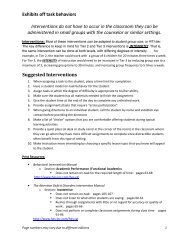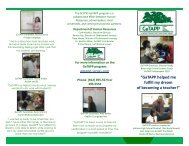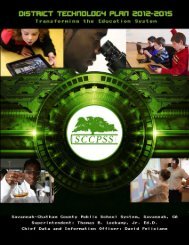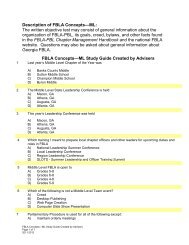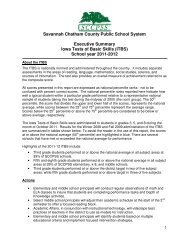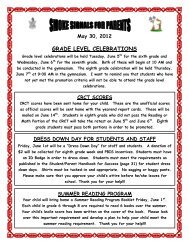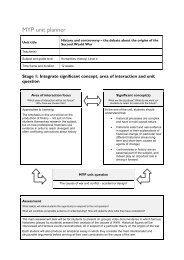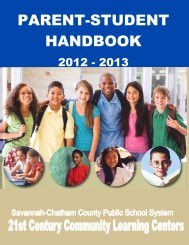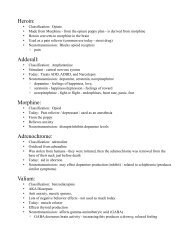SAA AP Course Offerings and Information - Savannah Chatham ...
SAA AP Course Offerings and Information - Savannah Chatham ...
SAA AP Course Offerings and Information - Savannah Chatham ...
Create successful ePaper yourself
Turn your PDF publications into a flip-book with our unique Google optimized e-Paper software.
SAVANNAH ARTS ACADEMY<br />
ADVANCED PLACEMENT COURSE OFFERINGS<br />
2011-2012<br />
Why Participate?<br />
Get a head start on college-level work.<br />
Improve your writing skills <strong>and</strong> sharpen your problem-solving techniques.<br />
Develop the study habits necessary for tackling rigorous course work.<br />
Demonstrate your maturity <strong>and</strong> readiness for college.<br />
Show your willingness to take the most rigorous courses available to you.<br />
Emphasize your commitment to academic excellence.<br />
Study subjects in greater depth <strong>and</strong> detail.<br />
Assume the responsibility of reasoning, analyzing, <strong>and</strong> underst<strong>and</strong>ing for yourself.<br />
General <strong>Information</strong>:<br />
Teacher recommendations are used as a basis for recommending students <strong>and</strong> predicting<br />
success.<br />
Students should select courses based on interest <strong>and</strong> academic strengths. <strong>AP</strong> contracts<br />
signed in the spring determine the master schedule; students will not be allowed to drop<br />
classes over the summer or in the fall.<br />
<strong>Course</strong> work is on the level of a freshman or sophomore college course; the College Board<br />
audits each syllabus to insure <strong>SAA</strong> is teaching a college-equivalent course.<br />
In college, students generally take four classes a semester; at <strong>SAA</strong> we take eight classes.<br />
All students who take the courses are required to take the exams. Students who are no-shows<br />
will have to pay a $20 return fee.<br />
The course work moves at a fast pace to cover all the st<strong>and</strong>ards.<br />
Students can expect to spend much more time on homework than in other courses.<br />
Making an “A” in an Advanced Placement course is much harder than in a <strong>SAA</strong> honors class.<br />
The majority of the courses require extensive summer reading.<br />
While the credit policies of individual schools of higher education vary considerably, the<br />
College Entrance Examination Board has established the following guidelines for Advanced<br />
Placement:<br />
o 5 = Extremely well qualified<br />
o 4 = Well qualified<br />
o 3 = Qualified<br />
o 2 = Possibly Qualified<br />
o 1 = No Recommendation<br />
Teachers listed below are currently teaching the courses; e-mail them for information that is<br />
more specific (click on Contact <strong>Information</strong>: www.savartsacademy.com).<br />
The <strong>SAA</strong> syllabi <strong>and</strong> pacing guides are available on the <strong>SAA</strong> website.<br />
Visit the College Board website for more information<br />
http://apcentral.collegeboard.com/apc/public/courses/descriptions/index.html<br />
Accel (joint enrollment) courses do count toward HOPE hours; <strong>AP</strong> courses do not; see Georgia<br />
411 information at http://www.gsfc.org/main/publishing/pdf/411/hope_gpa_essentials.pdf<br />
For further information, call Mary Ann King, <strong>AP</strong> Coordinator, at 395-1430 or e-mail at<br />
maryann.king@sccpss.com<br />
2/8/2011 adv placement/student-parent h<strong>and</strong>out P a g e | 1
<strong>AP</strong> Biology; Steve Ricciardi (11 th or 12 th grade; prerequisite: Biology, Chemistry, <strong>and</strong> Physics)<br />
<strong>AP</strong> Biology is designed to be the equivalent of a college introductory biology course usually<br />
taken by biology majors during their first year. The course aims to provide students with the<br />
conceptual framework, factual knowledge, <strong>and</strong> analytical skills necessary to deal critically with the<br />
rapidly changing science of biology. Students who take this course will develop an appreciation of<br />
science as a process. There are three main areas of <strong>AP</strong> Biology: Molecules & Cells, Heredity &<br />
Evolution, <strong>and</strong> Organisms & Populations.<br />
<strong>AP</strong> Calculus AB; Dan Snope (11 th or 12 th grade; prerequisite: Accelerated Math 3 or Trig)<br />
The <strong>AP</strong> Calculus AB course content is that of a freshman college calculus class; it includes<br />
topics on differential <strong>and</strong> integral calculus as well as basic work in differential equations. Students<br />
must be comfortable doing mathematics with <strong>and</strong> without a graphing calculator. Students are<br />
required to take a diagnostic test in May, complete a take-home summer exam <strong>and</strong> a summer book<br />
report. A quiz on functions is given the first day of class<br />
<strong>AP</strong> Calculus BC; Dan Snope (12 th grade; prerequisite: <strong>AP</strong> Calculus AB)<br />
<strong>AP</strong> Calculus BC includes all the material from AB as well as more advanced work in all areas<br />
of single variable calculus. This course is the equivalent of a Calculus II college class <strong>and</strong>, upon<br />
successful completion of the end of course exam, most colleges will award the student two full course<br />
credits <strong>and</strong> entrance into the next level of calculus. This is a rigorous course; a summer book report<br />
is required.<br />
<strong>AP</strong> Chemistry; Cindy Hicks (12 th grade; prerequisites: Biology, Chemistry, <strong>and</strong> Physics)<br />
This course is designed to be the equivalent of the general chemistry course usually taken<br />
during the first college year. Students should attain a depth of underst<strong>and</strong>ing of fundamentals <strong>and</strong> a<br />
reasonable competence in dealing with chemical problems. The course will contribute to the<br />
development of the students' abilities to think clearly <strong>and</strong> to express their ideas, orally <strong>and</strong> in writing,<br />
with clarity <strong>and</strong> logic.<br />
<strong>AP</strong> English Language <strong>and</strong> Composition; Bradley Wallace (11 th grade; prerequisite: Am. Lit.)<br />
The <strong>AP</strong> English Language <strong>and</strong> Composition course is equivalent to an introductory college<br />
composition course. The course helps students become skilled readers of prose written for a variety<br />
of purposes, aware of the interactions among a writer’s purpose, audience expectations, <strong>and</strong><br />
subjects. Students will be required to read approximately 4000 pages of text in addition to writing<br />
several essays. Students who elect to take <strong>AP</strong> English Language <strong>and</strong> Composition must be<br />
independent workers, self-motivated, <strong>and</strong> have at least ten hours per week to dedicate to the<br />
completion of course work outside of class.<br />
When students attend the information session, they will take a Mock <strong>AP</strong> English Language<br />
Exam to help identify preparedness for the rigor of the course. This course is NOT a creative writing<br />
course, but a course in Rhetoric.<br />
<strong>AP</strong> English Literature <strong>and</strong> Composition; Debbie Crawford (12 th grade)<br />
The <strong>AP</strong> English Literature <strong>and</strong> Composition course is designed to engage students in the<br />
careful reading <strong>and</strong> critical analysis of imaginative literature. The course includes an intensive study<br />
of representative works from various genres <strong>and</strong> periods, concentrating on works of recognized<br />
literary merit. Writing assignments will focus on critical analysis <strong>and</strong> interpretation of selected<br />
literature <strong>and</strong> poetry. The student will also develop an underst<strong>and</strong>ing of chronological context <strong>and</strong> the<br />
relevance of period structures in British literature.<br />
Students will be provided with an excellent resource –Perrine’s Anthology. They will be<br />
required to purchase Thomas Foster’s How to Read Literature Like a Professor. We have a host of<br />
selected literature that will be required reading throughout the school year. Your child will read <strong>and</strong><br />
2/8/2011 adv placement/student-parent h<strong>and</strong>out P a g e | 2
analyze various works such as: Brave New World, The Metamorphosis, Siddhartha, Frankenstein,<br />
Death of a Salesman, Invisible Man, Othello, <strong>and</strong> Fences. We will also focus on British <strong>and</strong> American<br />
poetry with a culminating assignment in the form of a senior research paper.<br />
The study of literature <strong>and</strong> poetry will require active outside reading, class participation, <strong>and</strong><br />
the completion of analytical essays that reflect the st<strong>and</strong>ards <strong>and</strong> requirements of the College Board’s<br />
<strong>AP</strong> program.<br />
<strong>AP</strong> Environmental Science; Cindy Hicks (11 th or 12 th grade; prerequisites: Biology <strong>and</strong><br />
Chemistry)<br />
<strong>AP</strong> Environmental Science includes: classroom instruction followed by laboratory <strong>and</strong> field<br />
investigations. An emphasis is placed on: the scientific principles, concepts, <strong>and</strong> methodologies<br />
required to underst<strong>and</strong> the interrelationships of the natural world through the use of previous<br />
knowledge with biology, chemistry, physics <strong>and</strong> math; to identify <strong>and</strong> analyze environmental problems<br />
both natural <strong>and</strong> manmade; to evaluate the relative risks associated with natural <strong>and</strong> manmade<br />
problems: to examine alternative solutions for resolving <strong>and</strong>/or preventing environmental problems.<br />
Students must be willing to work hard, think critically, <strong>and</strong> complete various assignments in a timely<br />
fashion. Time management is a must!<br />
<strong>AP</strong> European History; Mary Summerford (11 th or 12 th grade; prerequisites: World & US<br />
History)<br />
The <strong>AP</strong> European History course covers European history from the Renaissance through the<br />
collapse of the Soviet Union. This college level course focuses on the political, economic, cultural<br />
<strong>and</strong> social aspects of Europe from 1400-1991. The primary goal is to enlighten students <strong>and</strong> to foster<br />
an interest in the study of historical events.<br />
This course is for the seasoned advanced student. An advanced intellect <strong>and</strong> a mature work<br />
ethic are essential qualities needed to obtain a successful score on the <strong>AP</strong> exam. It is assumed a<br />
student registering for this course is prepared for a rigorous schedule that will include: weekly<br />
extensive reading of our college level textbook, analysis of primary documents, development of<br />
critical thinking skills, extensive essay writing, projects, <strong>and</strong> assigned book readings (including<br />
summer reading).<br />
<strong>AP</strong> Music Theory; Carl Polk (11 th or 12 th grade; prerequisite: Music Theory)<br />
The <strong>AP</strong> Music Theory course exp<strong>and</strong>s upon the academic <strong>and</strong> aural skills learned in the ninth<br />
grade Music Theory/Composition course. This course is designed to develop musical skills that will<br />
lead to a thorough academic <strong>and</strong> aural underst<strong>and</strong>ing of music composition <strong>and</strong> music theory.<br />
Students are prepared to take the <strong>AP</strong> Music Theory Exam when they have completed the course.<br />
Students planning to major in music in college may be able to enroll in an advanced music theory<br />
course, depending on individual colleges’ <strong>AP</strong> policies.<br />
<strong>AP</strong> Physics B; Amy Durden (11 th or 12 th grade; prerequisite: Accelerated Math 3 or Trig)<br />
This is a college-level introductory survey course. <strong>AP</strong> Physics covers the areas of Newtonian<br />
Mechanics, Fluid Mechanics, Thermal Physics, Electricity <strong>and</strong> Magnetism, Waves <strong>and</strong> Optics, <strong>and</strong><br />
Atomic <strong>and</strong> Nuclear Physics. It is a very challenging course <strong>and</strong> test <strong>and</strong>, unlike many other <strong>AP</strong><br />
courses, is the equivalent to two full semesters of college work including laboratory. The pace,<br />
therefore, is rapid <strong>and</strong> intense. Students must have excellent math skills <strong>and</strong> be willing to work <strong>and</strong><br />
study independently at a college level in order to be successful.<br />
<strong>AP</strong> Physics C Mechanics/<strong>AP</strong> Physics C Electricity <strong>and</strong> Magnetism; Amy Durden (12th grade;<br />
prerequisites: Physics B suggested; already or concurrently taking Calculus)<br />
<strong>AP</strong> Physics C is equivalent to the two semester beginning physics sequence for engineering or<br />
science majors. It provides an in-depth development of the physics concepts <strong>and</strong> principles of<br />
2/8/2011 adv placement/student-parent h<strong>and</strong>out P a g e | 3
mechanics, electricity <strong>and</strong> magnetism, with an emphasis on inquiry <strong>and</strong> critical thinking skills including<br />
problem solving, deep mathematical reasoning, <strong>and</strong> experimental investigations. Semester One,<br />
Mechanics, focuses on topics of study including kinematics, Newton’s laws of motion, work <strong>and</strong><br />
energy <strong>and</strong> power, systems of particles <strong>and</strong> linear momentum, circular motion <strong>and</strong> rotation, <strong>and</strong><br />
oscillations <strong>and</strong> gravitation.<br />
Semester Two, Electricity <strong>and</strong> Magnetism, focuses on topics of study including electrostatics,<br />
conductors <strong>and</strong> capacitors <strong>and</strong> dielectrics, electric circuits, magnetic fields, <strong>and</strong> electromagnetism.<br />
Laboratory work is an integral component of this course. Calculus is used throughout the course <strong>and</strong><br />
is a co-requisite. Students taking this course will take two separate 90 minute <strong>AP</strong> Exams.<br />
<strong>AP</strong> Spanish Language; Ms. Maria Verwiel or Terry Finlay (11 th & 12 th grade; prerequisite:<br />
Spanish IV)<br />
The <strong>AP</strong> Spanish Language course is designed to be comparable to the third-year<br />
college/university Spanish language courses in advanced Spanish writing <strong>and</strong> conversation. It<br />
encompasses aural/oral skills, reading comprehension, grammar, <strong>and</strong> composition. Students who<br />
elect to take <strong>AP</strong> Spanish language must be independent workers, self-motivated, <strong>and</strong> have at least<br />
ten hours per week to dedicate to the completion of course work outside of class.<br />
Students who enroll should have successfully completed the fourth year of study in Spanish<br />
<strong>and</strong> possess knowledge of the language <strong>and</strong> culture of Spanish-speaking peoples <strong>and</strong> have attained<br />
a fourth-year level of proficiency in listening comprehension, speaking, reading <strong>and</strong> writing. Class<br />
time is used to improve skills in speaking <strong>and</strong> listening in Spanish; therefore, excellent attendance is<br />
a must for this class. To improve skill in reading <strong>and</strong> writing, Spanish assignments will be given to<br />
students all year including vacations to improve reading <strong>and</strong> writing skills.<br />
<strong>AP</strong> Statistics; Craig Sapp (12 th grade; prerequisite: Accelerated Math 3 or Trigonometry)<br />
The purpose of this course is to introduce students to the major concepts <strong>and</strong> tools for<br />
collecting, analyzing, <strong>and</strong> drawing conclusions from data. Students are exposed to four broad<br />
conceptual themes: exploring data (describing patterns <strong>and</strong> departures from patterns); sampling <strong>and</strong><br />
experimentation (planning <strong>and</strong> conducting a study); anticipating patterns (exploring r<strong>and</strong>om<br />
phenomena using probability <strong>and</strong> simulation); <strong>and</strong> statistical inference (estimating population<br />
parameters <strong>and</strong> testing hypotheses). <strong>AP</strong> Statistics is comparable to a freshman college statistics<br />
course.<br />
<strong>AP</strong> Studio Art: Drawing & 2-D Design; Steve Schetski (11 th or 12 th grade; prerequisite: Draw I)<br />
<strong>AP</strong> Studio Art is offered to visual arts students to introduce a variety of approaches <strong>and</strong><br />
drawing materials in Drawing <strong>and</strong> 2-D Design. These courses are offered to students who are<br />
serious in creating a quality art portfolio. The portfolio may be used for college application <strong>and</strong> will<br />
also be submitted in its final form to the College Board’s exam at the end of the school year in May.<br />
The portfolio will be completed in both the traditional fashion <strong>and</strong> in digital format. This is a<br />
great opportunity for students to focus on their work <strong>and</strong> produce not only quality works, but spend<br />
studio time to develop as an artist. The total portfolio consists of 12 original works in Breadth using a<br />
variety of materials, subjects, methods, etc., <strong>and</strong> 12 original works in Concentration (following a<br />
central theme or idea).<br />
<strong>AP</strong> Studio Art: 3-D Design; Trellis Payne (11 th or 12 th grade; prerequisite: Sculpture I, Pottery<br />
I, or Applied Design)<br />
The 3-D Design portfolio is intended to address sculptural issues. Design involves purposeful<br />
decision making about using the elements <strong>and</strong> principles of art in an integrative way. In the 3-D<br />
Design Portfolio, students are asked to demonstrate their underst<strong>and</strong>ing of design principles as they<br />
relate to depth <strong>and</strong> space.<br />
For this portfolio, students are asked to demonstrate mastery of 3-D design through any threedimensional<br />
approach, including, but not limited to, figurative or nonfigurative sculpture, architectural<br />
2/8/2011 adv placement/student-parent h<strong>and</strong>out P a g e | 4
models, metal work, ceramics, <strong>and</strong> three-dimensional fiber arts. The portfolio will be completed in<br />
digital format.<br />
<strong>AP</strong> United States Government <strong>and</strong> Politics; Gerald Kincaid (12 th grade; prerequisites: World &<br />
US History; Economics <strong>and</strong> Government)<br />
This course provides an analytical perspective on government <strong>and</strong> politics in the United States.<br />
This course involves both the study of general concepts used to interpret U.S. politics <strong>and</strong> the<br />
analysis of specific case studies. It also requires familiarity with the various institutions, groups,<br />
beliefs, <strong>and</strong> ideas that constitute U.S. political reality.<br />
<strong>AP</strong> United States History; Gerald Kincaid (10 th or 11 th or 12 th grade; prerequisite: World<br />
History; US History preferred)<br />
This course is designed to challenge students with the dem<strong>and</strong>s equivalent to those made in<br />
an introductory college course. The course provides a comprehensive overview of U.S. History while<br />
enhancing students’ analytical skills <strong>and</strong> factual knowledge regarding United States history. The<br />
instructor uses a variety of instructional practices including: class discussions, lecture, group work,<br />
individual projects, maps, videos, graphs, outside reading assignments, <strong>and</strong> study guides. Students<br />
are required to complete frequent writing assignments which include: essays, article reviews, <strong>and</strong><br />
document analysis. The <strong>AP</strong> US History course assumes a high level of motivation <strong>and</strong> disciple as<br />
well as academic ability.<br />
COURSE CRITERIA<br />
Students must attend an after-school information session with the <strong>AP</strong> teacher <strong>and</strong> have the criteria<br />
form signed by the <strong>AP</strong> teacher. Students must meet ONE of the following TWO criteria which can be<br />
verified by a current or former teacher; Ms. King or Ms. Tuten will verify test scores.<br />
CRITERIA 1:<br />
_____85 or higher in previous honors or <strong>AP</strong> course in this subject area<br />
CRITERIA 2:<br />
_____PSAT Reading score of 50 or higher (rising seniors)<br />
_____PSAT Reading score of 52 or higher (rising juniors)<br />
_____PSAT Reading score of 54 or higher or Stanine of 7 or better on a nationally normed<br />
st<strong>and</strong>ardized test (rising sophomores)<br />
ADDITIONAL CRITERIA FOR PHYSICS AND CALCULUS COURSES:<br />
_____PSAT Math score of 55 or higher<br />
Criteria to use for Music Theory <strong>and</strong> Art Portfolio courses ONLY:<br />
_____85 or higher in major art courses<br />
In addition to the criteria above, the student must sign <strong>and</strong> return the <strong>AP</strong> commitment form<br />
with a parent signature as well as the course criteria form which is signed by teachers. These<br />
forms <strong>and</strong> a schedule of after-school information sessions will be available when registration<br />
begins in late February.<br />
2/8/2011 adv placement/student-parent h<strong>and</strong>out P a g e | 5




